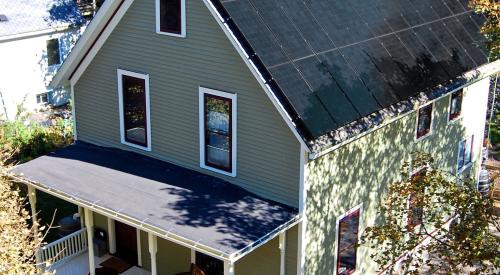With energy prices on the rise, buyers are becoming increasingly attracted to the notion of high-performance homes. High-performance homes offer consumers relief with lower energy costs while providing a more comfortable indoor environment and a higher level of indoor air quality. Many high-performance homes also include more weather-resistant exteriors, helping to spare buyers from expensive repairs and replacements. J.D. Power and Associates reported during the 2002 Energy & Environmental Building Association (EEBA) Conference that 88 percent of homeowners are "less than completely satisfied" with their homes. This statistic may indicate that consumers are willing to invest more up front for better homes.
Buyers have more sources of information than ever before about the home products and features available to them. But even with all of the information available to consumers, most don't know enough about high-performance homes. Many buyers have heard that the extra cost involved in purchasing a high-performance home will pay for itself, but they aren't sure how or when they'll see savings.
Buyer EducationEducating buyers about the benefits of high performance has to start with educating the sales staff; many builders don't have a sales force that understands the technical details behind high-performance features. As Vernon McKown, president of sales for Ideal Homes, notes, "It's been a robust market for so long that we've been tempted to neglect the discipline of selling homes." Ideal Homes, an Oklahoma City-based builder, has been fine tuning its sales strategy since 1997 to connect with savvy buyers. The company employs a simple strategy to educate buyers about high performance. "We show buyers an accurate cost-benefit picture, and they understand it quickly."
McKown encourages colleagues not to underestimate potential buyers. "One common mistake is to assume that since the majority of home customers are women, they don't care about energy costs — they just want tile floors and countertops. Making this assumption can be a costly error," he says. In reality, all buyers, including women, who reportedly make 80 percent of all final home-buying decisions, are interested in durability, energy efficiency, indoor air quality and other high-performance features, he says.
McKown points out that buyers don't need the right information to convince them to opt for high performance. Builders fly in from all over the country to ask Ideal Homes how to sell high-performance homes, but the approach is simple, says McKown. "You engage customers, treating them like the savvy, intelligent people they are. All it takes is for them to visit our model homes. They see and hear about the benefits our homes offer, and they're sold." Buyers need details, McKown explains. "If we say, 'Your home will be built to the Environments for Living (EFL) Platinum standard,' buyers will say, 'So what?' But if we say, 'Your home will be built to the EFL standard, which means that it will have airtight construction, higher R-value insulation, efficient appliances and fresh-air ventilation,' they'll be interested." Ideal Homes also gives buyers guarantees about monthly energy costs.
Buyers Teach, Too  Mattamy Home's Green Iniative demonstration homes feature Energy Star appliances. |
To sell high-performance homes, it's just as important to learn from buyers as it is to educate them. What features do buyers want in a high-performance home, and what are they willing to pay for them? Oakville, Ontario, home builder Mattamy Homes has designed and constructed two demonstration homes to help them answer such questions. Mattamy uses these demonstration homes — called Green Initiative Homes — to test the market for green home features, including high performance. As Mark McHone, president of Mattamy's Halton division in Ontario, explains, "We needed input from homeowners on what they're willing to spend on green, high-performance homes, so we designed and constructed the demonstration homes as part of our Hawthorne Village community."
 Green Initiative bathrooms feature faucets with automatic sensors, low-flow aerator showerheads and dual-flush toilets. |
As visitors tour Mattamy's demonstration homes and learn about their features, they can provide feedback with special hand-held devices called GreenPoint Readers, electronic data collectors developed specifically for the project by Endo Networks, a company that specializes in connecting with consumers in engaging ways. Customer responses to the demonstration homes will help Mattamy determine what benefits are important to buyers and what they're willing to pay for them. Signs throughout the two homes detail the cost of each high-performance feature and break down the cost of adding the feature to a mortgage. The monthly savings the consumer can expect from installing a feature is posted.
The project has been a great success. "The homes have been open since July, and so far, we've shown them to more than 5,000 people and collected 400 surveys," McHone says. The firm hopes to collect at least 1,000 surveys to better grasp what buyers want of high performance and green building. The Green Initiative program has already won Mattamy a Healthy Housing Recognition Award from the Canada Mortgage and Housing Corp.
Looking Forward  Signs throughout Mattamy Home's Green Iniative demonstration homes explain the benefits of energy-saving features. |
While some technologies such as wind turbines and solar electric generating panels in the demonstration homes aren't feasible yet for all homes, it's important to stay at the cutting edge and educate buyers now about future high-performance features, says McHone.
It's also important to give buyers a glimpse of upcoming features to develop their taste for better homes. As consumers learn more about the benefits of high performance features, they'll be more likely to buy homes that offer those benefits. "There's a lot of sales opportunity out there with high-performance homes," McKown says. "Offering high performance automatically makes selling our product easier. High-performance homes are good for our planet's future; they're also good for the industry."












